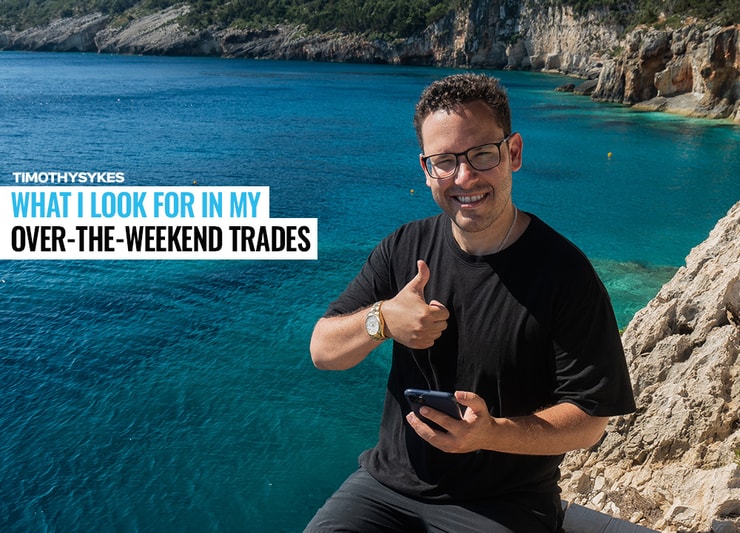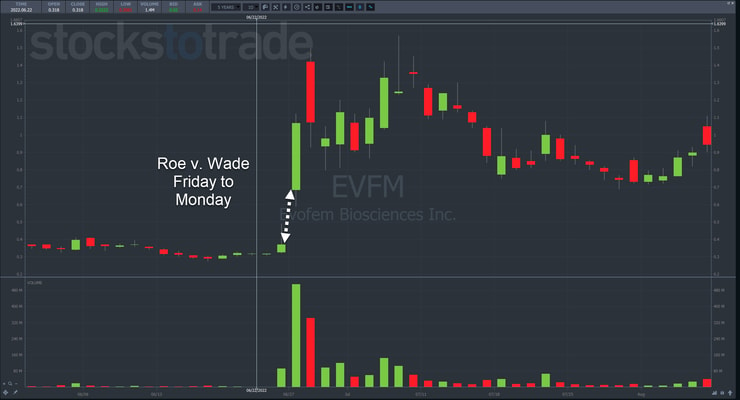Picture this…
It’s Friday afternoon, and you spot a beautiful setup.
You know the weekend is right around the corner, but decide to take a position anyways.
Monday rolls around, and your position is in the red.
Early in my career, I went through this same situation countless times.
I couldn’t figure out how to make these work consistently.
Rather than give up, I went back to what I knew best – finding an edge.
As I explained in a podcast interview with Brad Lea a few months back, I KNOW I trade garbage companies.
I assume promoters try to manipulate price and pull in suckers.
Rather than fight against them, I ride their tactics to profits.
I did it when I played Evofem Bioscieces Inc. (OTC: EVFM) off the Roe v. Wade reversal, which you can see here in my live webinar available on YouTube.
And it all comes down to this one critical factor that helps a stock move higher over the weekend.
Here’s what it is and how I applied it.
Consider The Catalyst

The majority of my trades in 2022, and most of my career, rely on some news catalyst.
With EVFM, I performed a simple logic exercise.
- Roe v. Wade overturned is a big deal
- People would want alternatives to birth control and related items
- EVFM develops products to prevent pregnancy
- People would buy EVFM
Since this all happened on a Friday, traders and investors would have the weekend to digest the news.
By Monday, I expected them and promoters to pump the name.
Sure enough, the stock skyrocketed over the weekend and I made a healthy profit.
Now, I was tipped off that this particular name could run on Friday.
You’ll notice that shares rose slightly on heavier volume.
That at least told me there was potential.
But, the play needed a true catalyst to push it over the top.
Dissecting Headlines

Learning how to read headlines can be tricky.
It’s why I dedicated a huge section of my Millionaire Challenge education to this very topic, with lessons on everything from reading SEC filings to share offerings.
However, it all starts with the headlines themselves.
For that, you have to be on top of your game.
Now, we’ve made it simple with our Breaking News chat room on our Stocks To Trade platform.
Our team delivers the headlines traders want that move the stocks we play.
For my money, it doesn’t get any easier.
When I read through headlines I ask myself the following questions:
- Does this matter?
- Is it new information?
- Is it timely?
A headline about a CEO speaking at a conference the following month isn’t a game changer.
But a biotech that receives FDA approval is.
These catalysts combined with chart setups are what create spectacular weekend trades.
That said, catalysts are just one leg to a trade’s foundation.
Bringing it All Together

A headline is only as good as the setup that goes along with it.
Two weeks ago, I bought shares of CGrowth Capital Inc. (OTC: CGRA) based on this tweet.
This purchase was on Tuesday, but it was still an overnight swing trade.
Now, the announcement wasn’t completely new information. There had already been news weeks ago about the acquisition.
However, this tweet teased its immediacy.
I entered the trade in the afternoon as volume picked up and bullish price action formed after the tweet.
The chart looked something like this:
My expectation was the stock would try to push through the recent highs and keep going.
However, I ended up closing the trade the following day, locking in a modest gain.
Over the years, I learned that red days that follow big green days tend to precede more red days.
If this was 2021, where everything would eventually run, I might have given it more time.
However, 2022 is the year of locking in profits when you get them.
So, I took this win and walked away… apparently a bit too early.
Since then, shares ripped and kept on going.
As this follows a recent pattern of runners, I will test a bit more aggression in the future.
However, the point here is that I stuck to my methods and strategies.
Sometimes it may leave money on the table.
But, the hardest part of trading isn’t winning…
It’s keeping your profits.
So, take trades that offer the best odds and cut losses quickly.
Slow and steady compounds greatly over time.
—Tim




Leave a reply